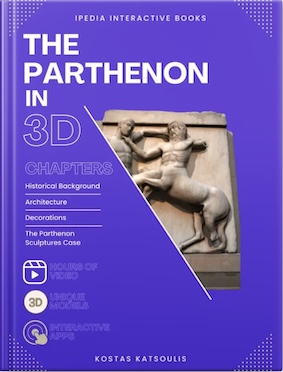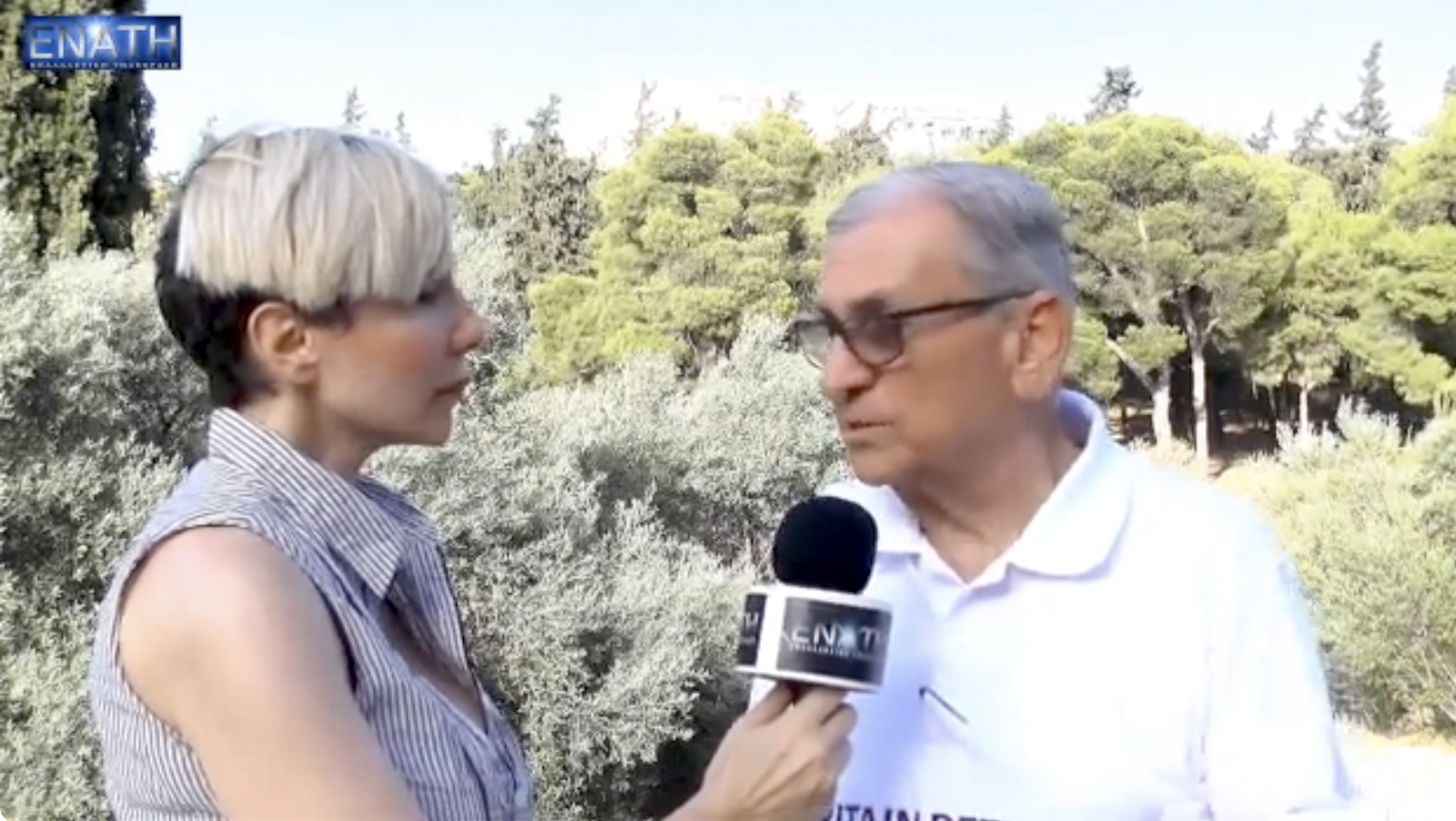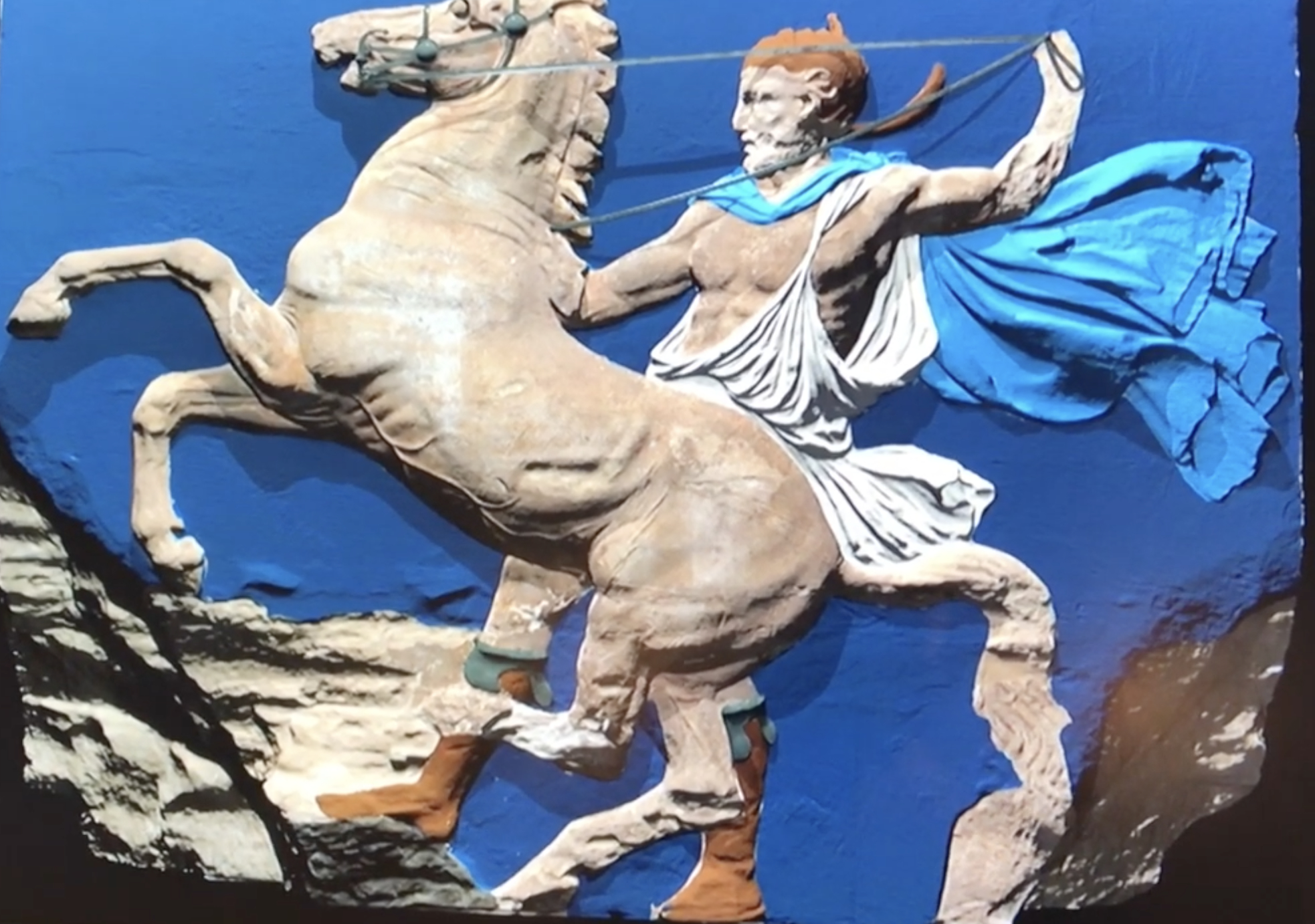
Emanuel J. Comino OAM, is the founder and Chairman of the International Organising Committee – Australia for the Restitution of the Parthenon Marbles which was formed in Australia in 1981 to work towards securing the repatriation of the famous marbles. Mr Comino has been campaigning for 30 years throughout Australia and the world for the return of the marbles. The following article is adapted from an illustrated presentation given by Mr Comino to the Macquarie Ancient History Association in 2005.
It is now over 200 years since Lord Elgin, British Ambassador to Constantinople at the beginning of the 19th Century, arranged for the removal of many of the magnificent sculptures from the Parthenon in Athens to England, where they remain to this day. These sculptures, otherwise known as the Elgin Marbles, but better known today as the Parthenon Marbles – even by the British Museum and the British Government – belong to a unique building that still stands after wars, earthquake and plunder. Despite a mounting international campaign, the British government has refused to return the marbles to Greece. Their return is one of the most important cultural property disputes in the world today. When we speak of the Parthenon, we are speaking about the birth of civilisation, the birth of democracy and the symbol of Greece.
The Parthenon, the Temple of Athena was built in 15 years between 447 to 432 BC by Iktinos, the architect and Phidias the sculptor. The man responsible for the project was the great Athenian statesman, Pericles who began a huge program of building works to give Athens the magnificence of a great imperial city. In these few years Greek literature, philosophy, architecture, politics – in fact the whole of the Greek civilisation – suddenly burst into flower.
Those of you who have visited Greece will have your own recollections of that magic moment when you walked up the Acropolis and saw the Parthenon for the first time. It is a Doric temple built entirely of white Attic Pentelic marble with a row of 17 elegant Doric columns on either side, eight at either end and a double row of six in the porches at each end. The internal eastern chamber or cella of the temple once housed a 12 metre-high statue of the goddess Athena wrought in gold and ivory. The Parthenon sculptures featured in the triangular pediments at each end, in the 92 metopes running the length of the temple on either side outside the building, and in the magnificent 160 metre long frieze high up on the interior of the building.
The pediment sculptures were huge statues in the round depicting the story of the quarrel between the goddess Athena and Poseidon over the naming of the city of Athens and the birth of Athena with all of the other gods looking on in amazement. The metopes were sculptures in high relief telling stories from Greek mythology, and the frieze, wrought in low relief, represented the ancient week-long festival of the Panathenaia. It consisted of 400 human and 200 animal figures.
Most of the statues from the pediments are now in the British Museum along with fifteen of the original 92 metopes. Many others were smashed during the removal of the sculptures. Of the original 160 metre long frieze, more than half is now in the British Museum. Huge 10 metre long saws that were used to cut and slice the heavy one-metre deep marble into sections in prepaartion for their transportation to London caused irreparable damage to the building and to the sculptures. One of the most magnificent marbles is of the great sculptor Phidias himself. The details of his eyes, nose, beard, lips, robes and muscles are all rendered to perfection; including the shades on the sculptured marble which in ancient times were coloured with reds, blues and golds.
After the classical period, the Parthenon became a Christian church and in AD 450 it was dedicated to the Virgin Mary. In 1204 the French occupied Athens and turned the Parthenon into a Catholic church and in 1458 when the Turks arrived, the Parthenon became a mosque. In 1674 (13 years before the explosions which damaged the building), a French artist visiting Athens made drawings of the Parthenon sculptures. These drawings provide important evidence of how well preserved the marbles were at this time and how well the Turks were looking after the Parthenon – despite later claims to the contrary. The first significant damage in 21 centuries occurred on 26 September, 1687 when the Venetian General Francesco Morosini laid siege to Athens. During the siege, a Venetian cannon hit the Parthenon and blew up part of the roof but the majority of the sculptures remained fortunately, intact.
After capturing the Acropolis, Morosini attempted to remove the statue of Poseidon in his chariot which formed part of the west pediment sculptures. However, as they were being lowered to the ground, the ropes holding them broke and the figures were smashed. One hundred and fifty years later, when Elgin was removing the sculptures, he missed seeing the torso of Poseidon’s body and that is why this magnificent piece is now in the Acropolis Museum and not the British Museum.These treasures were taken between 1801 and 1803 while Greece was under Turkish rule. Elgin’s main reason for taking the marbles was to decorate his Scottish mansion, not to save them from the ‘barbaric hands of the Turks’ as was claimed by the British Museum trustees and supporters. After Elgin returned to England in 1806 and after getting into financial difficulties, he eventually sold them to the British government, who in turn placed them in the British Museum where they remain today.
Thomas Bruce, the seventh Earl of Elgin, was a Scottish aristocrat who had served in the British army as an officer, and as a consul before being appointed British Ambassador to Constantinople in 1799. Before leaving England to take up his post he married Mary Nisbett, the only child of wealthy parents. He took his team with him including Dr Rev. Phillip Hunt, his secretary Sir William Hamilton and others. Before he left England he was renovating his mansion in Scotland. It was his architect, Thomas Harrison who suggested to Elgin that he take advantage of his position of Ambassador to Constantinople to take with him artists and painters to make architectural drawings and plaster casts ‘to improve the arts in Great Britain’..
Lord Elgin took up the idea with the enthusiasm of a crusader but there was no suggestion that the originals (of the buildings and artworks) should be removed. He even asked the government of the day, the Prime Minister Mr Pitt and the foreign secretary, Lord Grenville to provide him with qualified men to make architectural drawings but was advised that any such activity needed to be funded from his own pocket. He left England for Constantinople in August 1789 on the HMAS Phaeton. Just one year before his departure Rear Admiral Sir Horatio Nelson had destroyed the French fleet in Egypt. Elgin stopped in Italy on his way to Constantinople and hired the services of an Italian artist, Giovanni Battista Lusieri, who was initially contracted for the three-year period of Elgin’s Ambassadorship. But the association was to last for twenty years – during which time Lusieri served as Elgin’s chief accomplice in the looting of Greek antiquities which only ceased with the outbreak of the Greek War of Independence in 1821 and Lusieri’s death in the same year.
Elgin was very warmly received on his arrival in Constantinople – thanks to the assistance Britain was giving to Turkey in defeating Napoleon’s forces in Egypt. His party was taken on golden chairs to the palace and lavishly entertained with two weeks of receptions and banquets during which he was served coffee in diamond cups and showered with gifts, including the use of a 200 tonne yacht for his private exploration of the Greek Islands. In August 1800, 12 months after his departure from England, his artists arrived in Athens to ‘improve the arts in Great Britain’. Athens was the 43rd city of European Turkey at this time; it was ruled by two officials, the Turkish Governor and a military governor called the Disdar.
In 1800 during Elgin’s term as Ambassador to Constantinople, his artist Lusieri and others were at first given permission to make drawings and casts of the Parthenon sculptures. However, they were ordered off the Acropolis by the local Turkish commandant who claimed that the British would be able to spy on the Turkish women in the nearby houses from their vantage on the Acropolis. It took a lot of persuasion (sweetened by bribes), on Lord Elgin’s part, to regain permission for his artists to resume their work which they did in February 1801. However, they were ordered out again in May 1801. Elgin’s agents, Lusieri and Rev. Hunt wrote immediately to Lord Elgin in Constantinople, begging him to obtain a firman, a letter from the Ottoman governor addressed to the local official in Athens, requiring him to grant a favour by allowing the artists to resume their work.
As it turned out, events far away in Egypt conspired to deliver to Elgin exactly what he was seeking. In June 1801, the final victory of the British expedition over the French in Egypt made Elgin one of the most highly favoured men in Turkey. The Ottoman government could not do enough to show their appreciation of the country that had made this victory possible and they showered gifts on Elgin and his officials. The success in Egypt brought Elgin to the pinnacle of his diplomatic career; he now enjoyed a position of influence at Constantinople such as no other ambassador has ever approached. The government in Britain was pleased and they told him so in an official letter.
Lord Elgin could never have removed the Acropolis sculptures without the following three conditions: Firstly, Greece was under Turkish rule. Secondly, it was that era when the big powers, Britain and France took whatever they wanted from the less powerful countries such as Greece and Egypt. And thirdly, Britain was the dominant power in the eastern Mediterranean at the time.
Back in Athens, where Elgin’s agents had in May, been ordered out of the Acropolis, Elgin was on the point of giving the whole enterprise away, such was his frustration with the Turkish officials. But who happened to be in Athens at that very time: his very rich in-laws, the Nisbets. When his father-in-law saw the magnificent work that had been done in those 3 months (February-May) by his artists, he wrote to Elgin in Constantinople, urging him to obtain the firman at all costs so the work could continue. Elgin opened negotiations with the local Pasha on the day he received his letter, 14th June 1801. Two days earlier Rev. Hunt had arrived back in Constantinople from Athens and was able to give Lord Elgin an eye-witness account of developments in Athens. It was Rev. Hunt who drew up the memorandum of 1 July 1801 for the firman. The text of the original memorandum is important because it became the text of the firman that was shortly issued. It sought permission for the following activities:
It is interesting to note that no specific permission was sought to remove sculptures from the building. The removal of the sculptures only took place as a series of accidents, all of them involving Dr Rev. Phillip Hunt. Firstly, the firman would not have been drafted in the form it was had not Rev. Hunt been in Athens in May when the trouble started and back in Constantinople in June/July when the good news from Egypt came through. Secondly, the firman would not have been interpreted in the way it was, had not Rev. Hunt himself, delivered it to Athens. When he arrived in Athens on 22 July he immediately asked the Turkish governor for permission to go up on the Acropolis to start the drawings and plaster casts. The authority was given for work on the Acropolis to be carried out from sunrise to sunset within the terms of the firman.
After this triumph, Rev. Hunt acted quickly. All the inscriptions lying about the Acropolis were collected and extensive excavation was begun. A few days later, Rev. Hunt made the decisive move. He asked the Turkish governor for permission to take down the metopes. But the governor hesitated, saying there was nothing in the firman that gave permission for sculptures to be removed from the building. However, with the aid of threats and bribes, Hunt managed to win the day. ‘With no great deal of difficulty, the vital twist to the firman was given on 31 July 1801’.[2] The metope sculptures were removed in just two days – causing in the process, significant damage the building and to the sculptures themselves.
Lord Elgin wrote in a letter to Lusieri and Rev. Hunt, ‘I should wish to have examples in the actual object, of each thing and architectural ornament – of each cornice, each frieze, each capital- of the decorated ceilings, of the fluted columns – specimens of the different architectural orders and of the variant forms of the orders, -of metopes and the like, as much as possible.’ [3] It seems clear that his intention was to decorate his castle in Scotland not save the sculptures ‘from the barbaric hands of the Turks’.
As the work of clearing and excavation was being carried out on the smaller adjacent temple, the Erechtheum, Hunt wrote to Elgin suggesting that the whole building could be removed and relocated in England. ‘If your Lordship would come here in a large Man of War that beautiful little model of ancient art might be transported wholly to England.’[4] Elgin was keen to act on this advice and wrote to Lord Keith in Britain requesting ‘a ship of war .. to stop a couple of days at Athens to get away a most valuable piece of architecture …for the Arts in England. Bonaparte’ he added, ‘has not got such a thing from all his thefts in Italy. Kindly attend to this my Lord.’[5] It was indeed fortunate for the future of the Erechtheum that no such ship was available at the time and so the little temple with its beautiful Caryatid Porch remains in situ although a piece of its cornice, an Ionic column and one of the Caryatid statues were taken. They are now on display in the British Museum. Once an ancient piece of art is removed from its original and historical context, it loses its aesthetic value and becomes a piece of archaeological interest and nothing else.
On the Acropolis, Hunt and Lusieri had engineering problems removing sculptures from the building. The damage caused by their work was remarked upon by a number of British travellers to Athens at this time. One, Edward Dodwell, an artist who spent time sketching on the Acropolis wrote ‘ I had the inexpressible mortification of being present when the Parthenon was despoiled of its finest sculpture, and when some of its architectural members were thrown to the ground…’ [6] Another British traveller commented in October 1801, on the damage to the building. He was Edward Daniel Clark and he noted that as one of the sculptures was being lowered to the ground the ropes holding it broke and the sculpture was smashed into a thousand pieces.
In April 1802, Lord Elgin made his first visit to Greece to see the work. He was so pleased with the progress that he hired more men and architects to complete the removal of the sculptures. Elgin arranged for 22 ships to transport 220 cases of the marbles and other antiquities to England. One of the ships was sunk in a storm and the marbles it was carrying lay in twelve fathoms of salt water for three years before they were recovered and sent on to England.
Between their arrival in England in 1804 and their sale to the British Museum in 1816, the marbles were stored in a coal shed in the grounds of Elgin’s London home. Elgin’s marriage failed during this time and when he found himself in extreme financial difficulty he began to negotiate for the sale of the marbles to the British Government. The Government eventually acquired them for the price of £35,000 and an Act of Parliament transferred ownership of the marbles to the nation. And so they found their way into the British Museum.
One of the very first to criticise Lord Elgin was none other than Lord Byron. In 1828, four years after Byron’s death, his poem ‘The Curse of Athena’, in which he refers to Elgin as a robber, was published for the first time in England. In another publication dating to 1818, we find Byron and other Englishmen – travellers and historians who have visited Greece, calling Elgin ‘a shameless thief’. Sir John Hobhouse, a friend and travelling companion of Byron noted on a chapel under the Acropolis the inscription, ‘What the crooks did not do here, the Scot did here’, an obvious reference to Elgin who was a Scotsman.
In 1890, an eight-page article entitled ‘The Return of the Elgin Marbles’, by Franklin Harrison appeared in the magazine Nineteenth Century. The writer appealed to the gentle feelings of the English people and maintains that ‘even if Elgin’s looting is excused, [note the first use of the word looting], the retaining in London of parts essential to the Parthenon is no longer tolerable or convenient. Their restitution is urgent both as an act of international justice and as an act beneficial to science and the arts. In the same article, Harrison also maintained the sculptures ‘were more dear to the Greeks than to the British and that for 2,400 years they had formed an integral part of Greece and were therefore much more sacred than the Tower of London or Westminster Abbey. What would be our feelings’ he wrote, ‘if some one had deprived us of our national monuments?’ [7]
In November 1928, Phillip Sassoon, Private Secretary to the British Prime Minister of the day, wrote to The Times, saying that when he visited the Acropolis ‘I found myself wondering whether, after all, the noble ruins of the Parthenon and the glorious atmosphere of Athens would not be a better setting than Bloomsbury for the most exquisite marbles in the world.’[8]
The sculptures from the pediments and frieze now on display in the British have suffered considerable damage since their removal from the Acropolis in the early 1800s. William Sinclair, the British historian has exposed the cover up by the British Museum Trustees of the enormous amount of damage they caused to the marbles. The building of a special gallery at the British Museum to house the Parthenon sculptures was funded by Lord Duveen – on condition that his name be attached to it. In the 1930s ,chemicals and wire brushes were used to scrape and ‘clean’ the marble. The only pieces that retain the natural honey colour of aged Pentelic marble are those that were not cleaned because they were considered too fragile.
In 1941 Sir Winston Churchill was asked in Parliament whether Britain would consider returning the Parthenon Marbles ‘in some recognition of Greece’s magnificent stand for civilisation against the might of Hitler’s army’.[9] Churchill neatly sidestepped the issue by replying that he would ‘look into it favorably after the war’. And that was where the matter rested for the next thirty or more years.
In more recent times, during the 1980s, the former actress and later Minister of Culture in the Greek Government, Melina Mercouri, brought the issue of the return of the marbles to world attention.
“More than any other manifestation of human genius, the monuments of Athens reflect a form of life and an attitude that put man in the centre of the world, that made beauty and proportion divine. The Parthenon, built by free men on the Acropolis rock, has for more than two thousand years continuously expressed the grandiosity of simplicity, the passion of wisdom, the love of beauty. The marbles define our soul. And the struggle for the return of pieces that were pillaged in the past is not cahuvinistic; it is a struggle that must be undertaken in the name of humanity, civilization and justice.”
Two years later in 1983, Melina Mercouri was instrumental in establishing a British committee in London, called The British Committee for the Restitution of the Parthenon Marbles whose current Chairman is Professor Anthony Snodgrass. In the same year the International Council of Museums, including the British Museum, met in London and overwhelmingly passed a resolution to initiate dialogue with an open minded attitude concerning requests for the return of cultural property. One thousand delegates voted in favour of the motion, nil against and ten abstentions, five of which were from the British delegation.
[1] St. Clair, W. Lord Elgin and the Marbles, Oxford University Press, 1998 p. 87
[2] Ibid., p.93
[3]Ibid., p. 99
[4] Ibid., p.100
[5] Navy Records Society, The Keith Papers, 1927-1955, II. p.405, cited in St. Clair, p. 101
[6] Op. cit., p. 102
[7] Hitchens, Christopher, The Elgin Marbles, p 67
[8] Ibid., p. 75
[9] Ibid.



